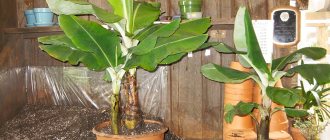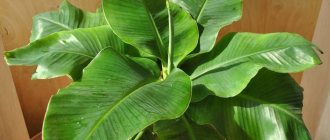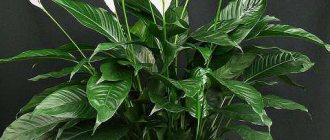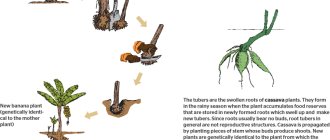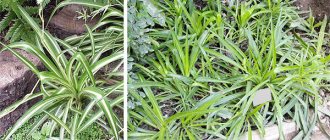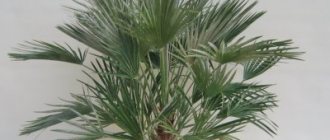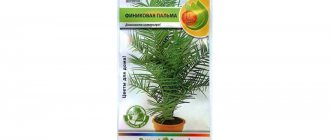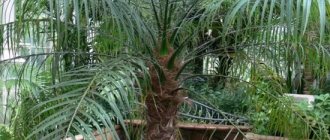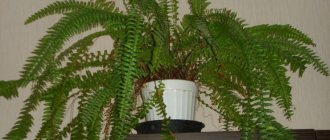Banana palm (tree) is an ornamental plant that will add exoticism to the interior, and with regular care it will begin to bear fruit. The plant requires a lot of light and space. If these conditions are not met, the leaves will begin to lose color and over time the palm tree will die. With appropriate treatment, after 1 - 2 years its height will be more than 2 m. In the 3rd - 5th year of cultivation, it begins to bear fruit. You can grow a palm tree yourself from seeds or a small shoot. It is not recommended to buy a large plant, as it has difficulty adapting to a new environment and may die. The article describes in detail how to grow a banana palm at home.
VARIETIES
The appearance of the plant will depend on the type of tree: height, trunk diameter, leaf size. The height of dwarf varieties is from 1.5 to 4 m. Below are varieties that are well suited as indoor plants.
- Red
- Cavendish
- Brazilian
- Jamaican
- Kyiv dwarf
- Rajapuri
- Williams Hybrid
- Lady fingers
- Gran Nain
PREPARATIONS
You will need: seeds or cuttings, soil, container for planting, fertilizers. Don't try to use seeds from a banana you bought at your local store. Only seeds or layering will give the desired result. How quickly the seeds germinate depends on the variety chosen. For some, 2 – 3 weeks are enough, while for others – 2 months. Be patient and the result will not keep you waiting. When the seed reaches a height of 10–12 cm, the plant should be transplanted into a larger pot. To do this, use the transshipment method so as not to injure the root system.
SEED PREPARATION
The protective skin of the banana seed must be broken so that water can seep into the embryo and it will sprout. A knife or needle is suitable for this. If the crust is pierced through, the seed will die. After this, the seeds must be treated with potassium permanganate for 30 minutes and then soaked in warm water for 24 hours.
LANDING
Fill a small container, 8–10 cm wide, with drainage (small pebbles or expanded clay). Approximately fill the middle of the pot with soil, place a banana seed in the middle and cover it with a small amount of soil. Water the soil well and then keep the soil moist. There must be a hole at the bottom of the container to allow excess water to escape so that it does not stagnate and the roots do not rot. Place the pot in a bright place without direct sunlight. It should be well lit for 13 - 14 hours. If there is a lack of natural light, take care of additional lighting for the plant. The pot must not be allowed to overheat, because... high temperatures can “cook” the roots and the plant will die. If mold appears, fill the soil with potassium permanganate.
Making a mini-greenhouse
To plant, you should take a small plastic cup and fill it with drainage. These could be small pebbles, expanded clay, broken dishes or tiles.
On top of the drainage we place a layer of soil mixture 5 cm thick, consisting of ¾ of well-washed river sand and ¼ of peat. There must be a hole in the bottom of the glass so that the water does not stagnate and, as a result, the roots do not rot.
We cover the glass with glass, so there should be some distance between the surface of the soil mixture and the glass so that the sprouts do not rest against the glass.
LIGHTING AND TEMPERATURE
If the plant is grown for the purpose of producing fruit, then additional lighting is required. The room temperature should be around 25C and above. At night the temperature may be lower, but not less than 20C. For decorative purposes, special lighting is not required and room temperature is sufficient. Under such conditions, the palm tree will bloom beautifully and for a long time. Temperatures below 16C can freeze plant growth, and temperatures below 0C can kill it.
WATERING
Use water that has stood for 24 hours, at a temperature several degrees above room temperature. Then the plant will develop without any difficulties. In summer, the plant needs more water, so water often and a lot (1 - 2 times a day). In winter, water when the top layer of soil dries out, about once every week and a half. With careful care, a new leaf will appear on it every week. Therefore, it is considered the record holder for growth among domestic plants.
Flower design
When choosing a plant, or rather a variety or type of banana, you need to understand where you will grow it. Several types of banana can be grown on a veranda or on a glassed-in terrace: these include: velvety banana, reaching 1.2 m in height, leaves 60 cm long, yellow flowers with red stipules, inedible fruits, as well as a dwarf species reaching 1.2 m in height, which is usually propagated by shoots and the bright red banana is only 90cm high. This tropical plant will bring into your interior like other tropical palms. Good luck to you.
HUMIDIFYING
The air in the room where the banana tree is located must be humid. Then the plant will actively grow and delight with new leaves. If the leaves begin to dry out, it is necessary to urgently take measures to irrigate it. To do this, moisten the plant regularly: spray it daily or wipe the leaves with a soft and damp cloth. Additionally, you can place open water bottles or a humidifier around. The plant also needs to be ventilated regularly: taken to the balcony when it’s warm, or kept near an open window for a short time. The main thing is to avoid strong gusts of wind and drafts.
TRANSFER
The banana palm has a relatively short lifespan. It grows quickly, begins to bear fruit and dies just as quickly. But in place of the dead plant, shoots will appear that are suitable for further planting. It is better to replant the tree into another pot or at least change the soil in the fall. Do this annually, because the palm tree, having taken all the useful substances from the soil, stops growing.
How to grow in open ground, where and under what conditions is this possible?
Banana palm, what trees do bananas grow on?
As already mentioned, banana grows mainly in the tropics. In Russia it grows south of Sochi, but does not bear fruit due to the harsh winter. There is a frost-resistant variety of banana palm, planting and caring for it in open ground does not require much expense. The name of this variety is Japanese banana.
Frost-resistant Japanese banana variety – Musa Basjoo
This banana should be planted in open ground in a sunny area, protected from winds that can fray the delicate leaves.
Watering is daily, excluding, of course, rain. Don’t forget about humidity, so on hot days you can also use sprinkling. To maintain soil moisture longer, mulching is also a good idea.
Important! This banana, of course, will not bear fruit, but will attract attention with its unusual “tropical” appearance.
When the growing season is over and the leaves fall off, it is necessary to cover the stem for the winter and cover it with soil. In this form, it can withstand frosts down to – 25 °C.
FRUITING
If you follow all the care recommendations, then over time the plant will begin to bear fruit. This can happen when there are at least 15 - 20 leaves on it. The fruits of the banana tree are berries, not fruits. They are distinguished by a variety of colors: from bright green to red and yellow, as well as by the taste of the fruit: from sweet to sweet and sour.
Mold control
If suddenly any signs of mold appear in the greenhouse, then the soil mixture should be spilled with a solution of manganese, and the glass should be thoroughly washed with detergent.
Do not despair, all these precautions should be observed only for a while, until the seeds germinate and the young shoots become stronger. In just a year, small young sprouts will become a large and strong plant with a stem diameter of up to 15 cm, resting on the ceiling and will become your pride, as it was grown at home. The thick stem of the banana palm, consisting of several leaf petioles, is the false trunk of the tree. It is formed by the curling of leaves during plant development.
DISEASES AND PESTS
The main pests of palm trees are weevils, spider mites or aphids. You can get rid of them using pesticides. The plant is disease resistant. If the plant is not developing properly, pay attention to its appearance. Perhaps he lacks something or, on the contrary, has something in excess.
- Growth has stopped, leaves have shrunk or withered - a lack of nutrients. Feed the plant with fertilizers and transplant it into a larger pot.
- The foliage dries, the shoots wither, the tip curls and turns yellow - the air is too dry. Increase the humidity in the room and spray the leaves more often.
- Dull and small foliage – lack of lighting. Use artificial lamps.
- Soft drooping leaves - the room is cold. Place the plant in a warm place where there are no drafts or cold air.
- Dark spots between the veins are a standard phenomenon that is characteristic of this type of plant.
- In the spring there is no active growth - carry out scheduled fertilizing or if additional is required.
- The stem darkened at the base - due to excess moisture, the base of the stem began to rot. Reduce watering, otherwise the plant will die.
Growing a banana palm is not so easy, but it will be a good addition to the interior. And if it begins to bear fruit, you will be able to delight yourself and your loved ones with fresh berries. All that remains is to choose: grow a plant from scratch or care for an adult.
Description of banana for home cultivation
Growing a banana tree at home is a doable task. Many gardeners make the mistake of imagining a banana as a palm tree. Culture (in Latin Musaceae) is a herbaceous perennial from the banana family.
The etymology of the Latin word is not known for certain. According to one version, the name comes from Anthony Muse, the court physician of the Roman emperor. Proponents of another theory claim that the lexeme has Arabic roots.
Banana fruits are not fruits, but berries. The banana trunk is located underground and serves as a root. The above-ground part is the foliage, which fits tightly together and forms a pseudostem. Leaf color is determined by the variety. It can be two-colored, green or spotted with inclusions.
The rhizome, or spherical stem, hides underground and replaces the rhizome of the tree. The main inflorescence emerges from the middle part of the pseudostem and dries after fruiting.
The life cycle is limited to 40 years. If plants are bred for industry, planting by basal shoots is among the growing methods. The method preserves the varietal properties of the crop.
60 varieties prefer the tropics and subtropics. They are found in Asian regions, on the black continent and in Australia. Goods are exported to Russia from countries such as Mexico, Ecuador, and Costa Rica.
For consumers, banana is a delicious berry or fruit. The fruits are valued in cooking: they are eaten raw and are suitable for boiling, frying, drying and baking. In terms of importance, fruit or dessert bananas are not only a source of income for a number of countries, but also the basis of the diet. In addition, banana applications include:
- alternative medicine;
- production of ropes, rafts, fishing equipment, seat cushions (technical grades);
- production of flour, food for livestock (fodder species);
- landscape design.
Gardeners are successfully engaged in decorative cultivation of plants in order to furnish the premises and experience the taste of juicy fruits. The growth of domestic bananas is from a meter to two, tropical counterparts - up to 12 m. Not all banana varieties can be eaten. To harvest fruits from a banana tree at home, low-growing species are suitable. Indoor banana is in demand among users:
| Variety | Peculiarities |
| Tropicana | Rich green oval leaves, 10 cm fruits |
| Apple or Manzano | The smell of strawberries and apples, blackened peel - an indicator of ripeness |
| Kyiv dwarf | Year-round flowering, yield – up to 200 small fruits |
| Dwarf Cavendish (Musa Dwarf Cavendish) | Short stature, compactness and beauty, abundant fruiting |
| Bloody | Inedible berries, burgundy-green foliage |
In order for a banana to delight you with its unusual greenery at home, it is important to create conditions for the exotic. The dwarf banana is a whimsical plant that needs care and attention.
